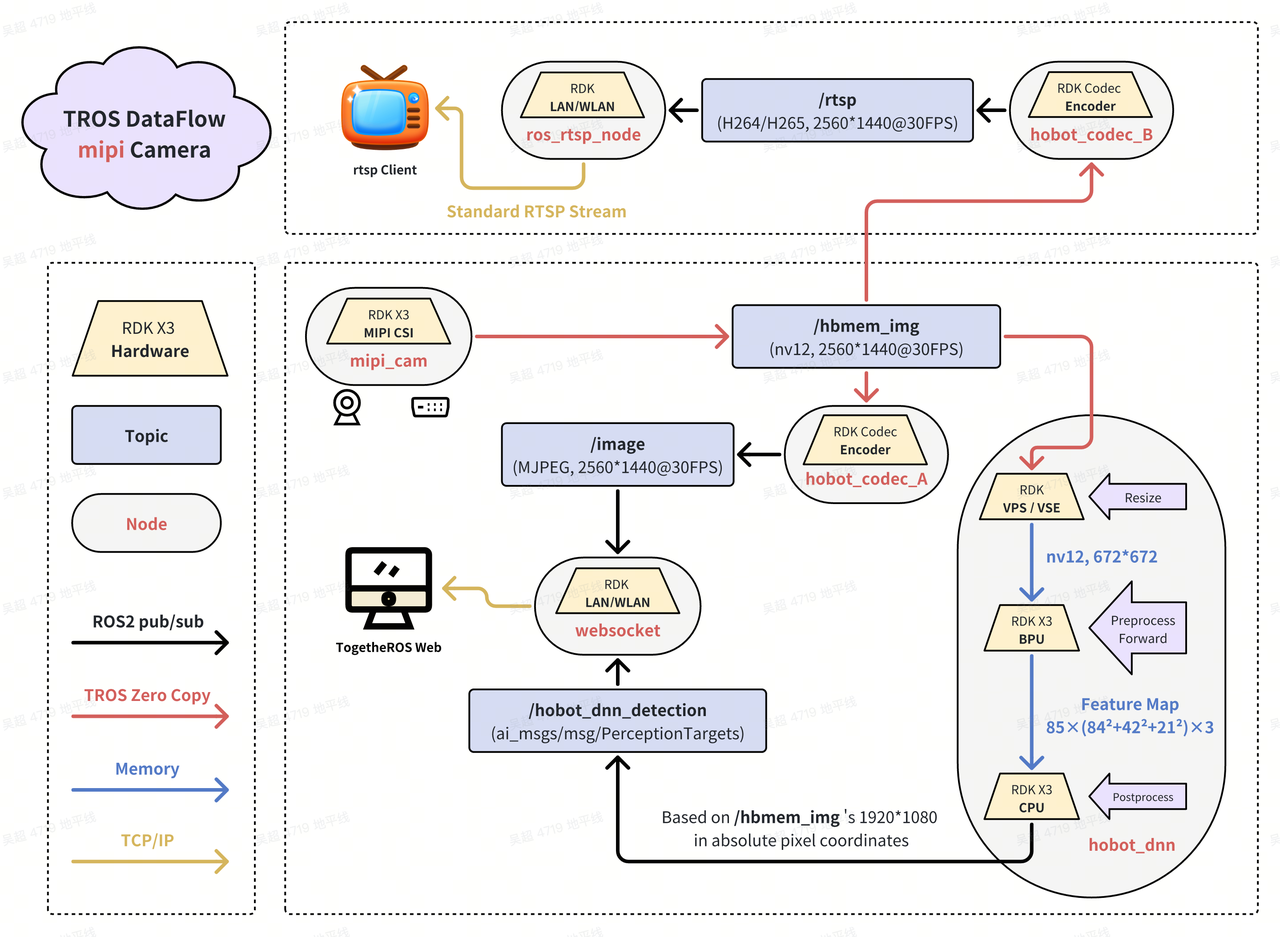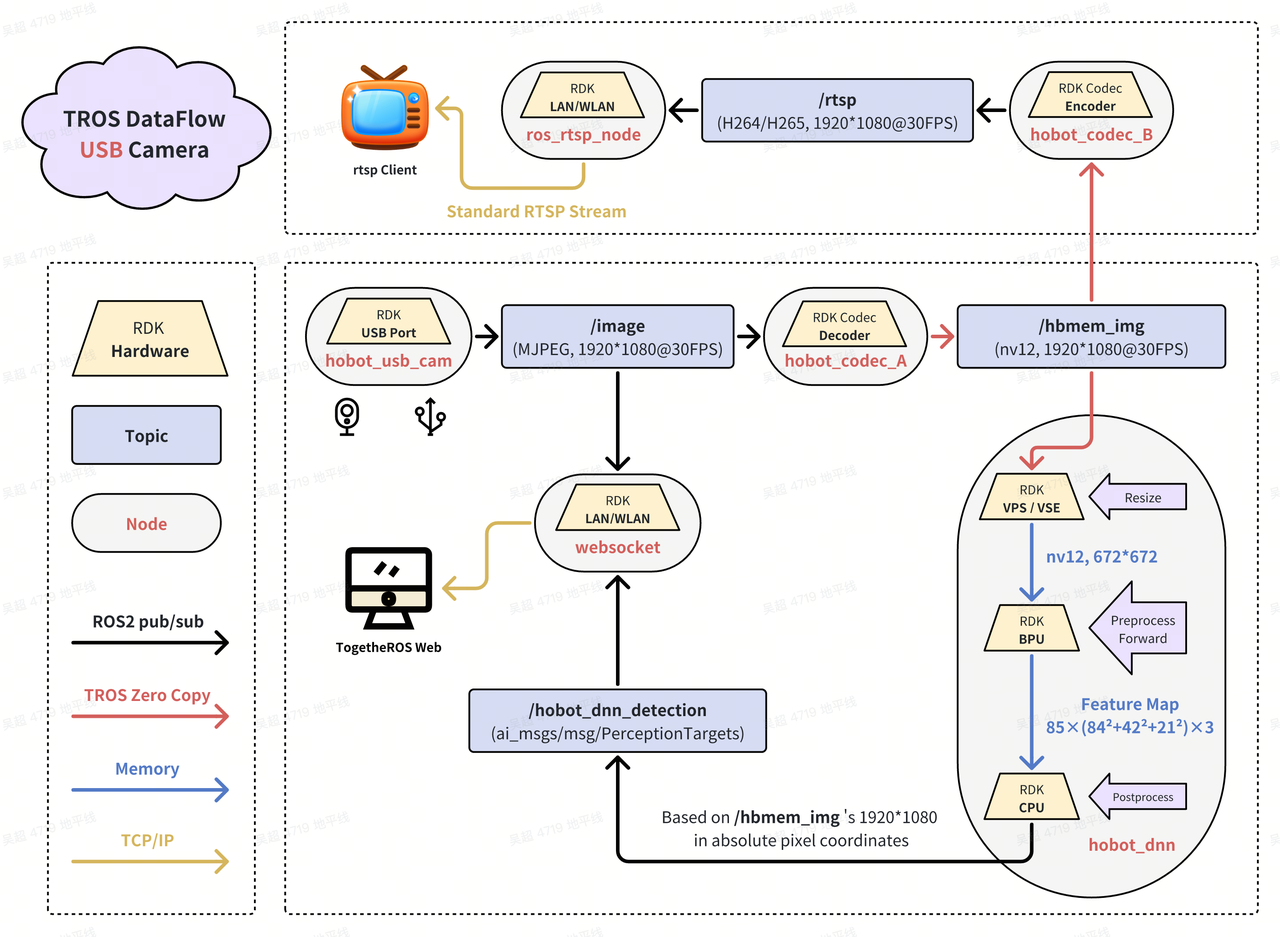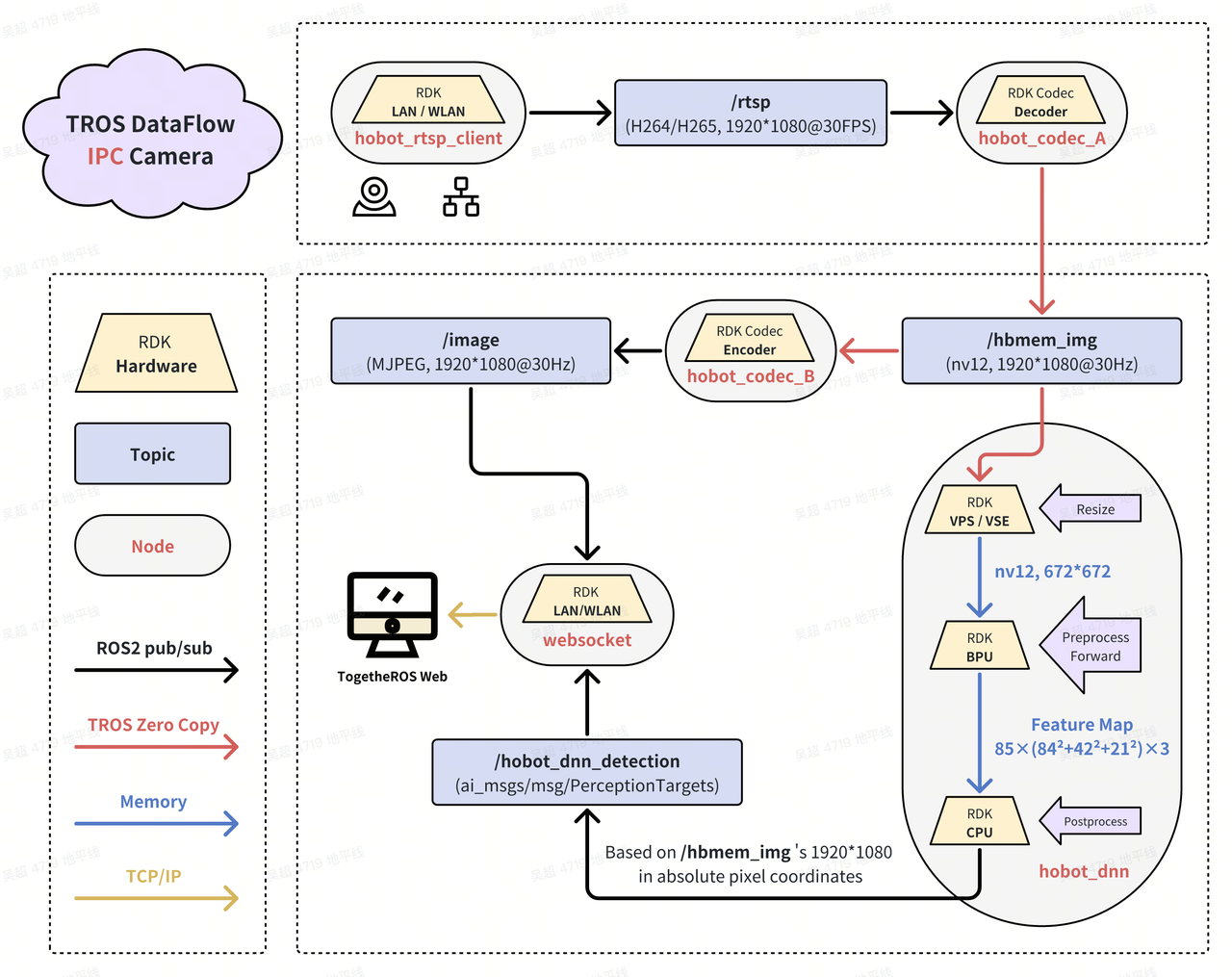8.6 TROS/ROS Development
This section addresses frequently asked questions about developing and using TogetheROS.Bot (TROS.b) and general ROS/ROS2 on the RDK platform.
Q1: What are the recommended troubleshooting steps if TROS-related packages fail to run?
A:
- Ensure your TROS packages are up to date: Many issues may have been fixed in newer versions. After confirming that the official Horizon APT sources (such as
sunrise.horizon.ccor the latestarchive.d-robotics.cc) are correctly configured, update all TROS-related packages:When seeking help, please provide your system and package version information using commands likesudo apt update && sudo apt upgraderdkos_info,apt list --installed | grep tros, andapt show <tros_package_name>. - Try to locate the problematic ROS node:
- Refer to the launch file of the relevant package and set the log level to
debug(e.g., add['--ros-args', '--log-level', 'DEBUG']to the node's arguments). - Relaunch the file and use the detailed debug logs to identify which node is causing the issue.
- TROS package launch files are usually located at
/opt/tros/<tros_distro>/share/<package_name>/launch/(e.g.,/opt/tros/humble/share/mipi_cam/launch/). - ROS2 log files are typically stored in
~/.ros/log/or/root/.ros/log/. Before troubleshooting, you can clear old logs withrm -rf ~/.ros/log/*(or the corresponding root path), then rerun the package to collect fresh logs.
- Refer to the launch file of the relevant package and set the log level to
- Reinstall the relevant TROS package:
- If you suspect a package's configuration is corrupted or incomplete, try reinstalling it.
- For example, to reinstall
hobot_usb_cam:- Find the exact package name:
apt list --installed | grep hobot-usb-cam - Remove the package:
sudo apt remove <tros_package_name_found> - Ensure APT sources are correct and update:
sudo apt update - Reinstall the package:
sudo apt install <tros_package_name_found>
- Find the exact package name:
Q2: What are the differences between TROS and standard ROS2? How to upgrade TROS Foxy to TROS Humble?
A:
-
Relationship between TROS and ROS2:
- TROS (TogetheROS.Bot) is Horizon's robot operating system, optimized and adapted from open-source ROS2 for its RDK hardware platform.
- It is usually built on a ROS2 LTS version, for example:
- On RDK OS 2.x (Ubuntu 20.04), TROS is based on ROS2 Foxy Fitzroy.
- On RDK OS 3.x (Ubuntu 22.04), TROS is based on ROS2 Humble Hawksbill.
- TROS integrates Horizon hardware drivers (BPU, VPU, JPU, sensors, etc.), hardware acceleration libraries, and optimized solutions and examples for common robotics functions.
- TROS is fully compatible with the core APIs and communication mechanisms of the corresponding ROS2 version, meaning nodes and services developed for standard ROS2 Foxy/Humble can usually run on TROS with little or no modification, and vice versa.
-
TROS version upgrade (e.g., Foxy to Humble):
- Since TROS versions are tightly coupled with the underlying Ubuntu version (e.g., Foxy with Ubuntu 20.04, Humble with Ubuntu 22.04), you cannot upgrade TROS from one major LTS version to another (e.g., Foxy to Humble) simply via
apt upgrade. - The correct way is: Flash a complete RDK OS system image that includes the new TROS version (e.g., Humble) and the corresponding Ubuntu version (e.g., 22.04).
- Since TROS versions are tightly coupled with the underlying Ubuntu version (e.g., Foxy with Ubuntu 20.04, Humble with Ubuntu 22.04), you cannot upgrade TROS from one major LTS version to another (e.g., Foxy to Humble) simply via
-
ROS2 runtime environment on the board:
- TROS itself is a complete ROS2 runtime environment on the RDK board.
- You can also install other standard ROS2 distributions (e.g., Foxy, Humble) or ROS1 (e.g., Noetic) on the board; they can coexist, but only one ROS environment should be sourced in a terminal session.
colconis a common ROS2 build tool. If not pre-installed, you may need to install it manually:sudo apt update
sudo apt install python3-colcon-common-extensions python3-catkin-pkg-modules python3-rosdep
# Or via pip:
# pip3 install -U colcon-common-extensions empy
-
Note: ROS packages compiled directly on x86 (not cross-compiled) cannot run on ARM-based RDK boards, and vice versa. Ensure your programs are compiled for the target architecture.
Q3: How is TROS installed on the RDK board? Is manual installation required?
A:
- TROS is pre-installed on the board when you flash the official RDK OS system image. You do not need to manually install TROS after flashing.
- You can update or incrementally install TROS packages via the APT package manager. With the official Horizon APT source configured,
sudo apt update && sudo apt upgradewill update installed TROS packages. - Older tools like
hhpor manual symlink steps are generally no longer needed in newer TROS versions.
Q4: Where can I find the source code for TROS-related packages?
A:
- TROS Manual: The official TROS user manual usually provides GitHub repository links for core packages or examples.
- NodeHub: If a package is provided via NodeHub (the Horizon robotics app store/component platform), its introduction page usually includes a source code link.
- GitHub D-Robotics Organization: Most open-source TROS packages are hosted under the D-Robotics organization (https://github.com/D-Robotics). Search for the package name to find its repository.
- README: Each TROS package repository typically contains a detailed
README.mdwith build instructions, usage, parameters, dependencies, etc.
Q5: What should I pay attention to when compiling TROS packages from source?
A:
-
When to compile from source:
- For experience: If you just want to try existing TROS features, you do not need to compile from source. Flash the latest RDK OS image and run pre-built packages.
- For secondary development: If you need to modify an official TROS package, download its source, modify, and compile it. It's recommended to compile directly on the RDK board (if resources allow), or in a cross-compilation Docker environment.
- Full TROS build: Building the entire TROS distribution from scratch is complex and usually requires the official cross-compilation Docker environment on a powerful x86 Ubuntu machine.
-
Cross-compilation Docker environment:
- Version matching: Ensure the Docker image version matches your target TROS version (Foxy or Humble) and RDK OS version.
- Source branch: When pulling source code, switch to the branch matching your TROS version (e.g.,
foxy,humble, or a specific release tag). Avoid usingmainordevelopunless you know it's compatible.
-
Dependency issues:
- You may encounter missing dependencies during compilation. Carefully read error messages to identify missing libraries or headers.
- Use
apt search <package_name>to find the Debian package, and install withsudo apt install <package_name-dev>. - For ROS dependencies, use
rosdep:sudo apt install python3-rosdep
sudo rosdep init # Only once
rosdep update
cd <your_ros_workspace_root>
rosdep install --from-paths src --ignore-src -r -y - The community usually cannot provide one-on-one support for individual build environments.
Q6: What if I get errors when installing standard ROS2 on the RDK board?
A: If you try to install a standard ROS2 distribution (e.g., Foxy, Humble) on the RDK board (which may already have TROS pre-installed) and encounter issues:
- Use recommended installation tools:
- Try popular third-party ROS installation tools, such as "FishROS One-Click Installer":
wget http://fishros.com/install -O fishros && bash fishros
- Try popular third-party ROS installation tools, such as "FishROS One-Click Installer":
- Install from source (if tools fail):
- If the one-click tool fails, clone the installer script from GitHub and run the Python script manually for more detailed output or customization:
git clone https://github.com/fishros/install
cd install
sudo python3 install.py
- If the one-click tool fails, clone the installer script from GitHub and run the Python script manually for more detailed output or customization:
- Check network and sources: Ensure the board has network access and can reach ROS and Ubuntu official sources.
- Check error logs: Carefully read any error messages during installation for clues (dependency conflicts, download failures, build errors, etc.).
Q7: What are recommended resources for multimedia (video streaming, encoding/decoding) in TROS?
A: The official TROS manual usually has dedicated sections or examples on using RDK multimedia capabilities in ROS2.
- Community Manual - Robot Development - Application Examples - Video Applications (video_boxs):
https://developer.d-robotics.cc/rdk_doc/Robot_development/apps/video_boxs
(Please verify the link is current and valid.)
This page or its subpages typically cover:
- How to publish image topics using MIPI or USB cameras.
- How to use hardware codecs (
hobot_codec) for image/video encoding (H.264, H.265, MJPEG) and decoding. - How to efficiently transfer image data between ROS2 nodes (possibly using zero-copy).
- Related sample code and launch files.



Q8: After launching a USB or MIPI camera node, the terminal says "[usb_camera_calibration.yaml] does not exist!" Is this normal?
A: This message is usually normal and does not necessarily mean the camera isn't working.
- Log level: Many ROS nodes default to
INFOorWARN. When starting, the camera node tries to load an intrinsic calibration file (usually a.yamlwith focal length, distortion, etc.). If not found, it warns but usually continues with default or uncalibrated parameters. - Function check:
- Even with this warning, the camera may be publishing images.
- In another terminal (after sourcing TROS), check:
ros2 topic list: See if image topics (e.g.,/image_raw,/image_color,/hbmem_img) are published.ros2 topic hz /your_image_topic_name: Check publish rate.ros2 topic echo /your_image_topic_name: See if image messages are output (will scroll quickly).- Use
rqt_image_view(on PC or board desktop) to view the image topic.
- When calibration is needed: If your application needs precise image measurements, 3D reconstruction, or undistortion, a correct calibration file is important. For simple display or AI inference, missing calibration may not matter.
Q9: Why does the browser not display images or AI results when using TROS WebSocket visualization?
A: There are many possible causes. Troubleshoot step by step:
-
Ensure relevant ROS nodes are running:
- Image publisher node: A node (e.g.,
mipi_cam,usb_cam, or playback node) must be publishing image topics. - AI inference node (if displaying AI results): A node must be publishing AI result topics.
- WebSocket node (
hobot_websocketor similar): This node converts ROS topics to WebSocket messages for the browser. - Use
ros2 node listandros2 topic listto check node and topic activity.
- Image publisher node: A node (e.g.,
-
Network connection and IP address:
- Ensure your PC (browser) and RDK board (WebSocket server) are on the same LAN.
- The browser must access the correct RDK board IP.
- Check for IP conflicts or routing issues.
-
Proxy server settings:
- If your PC uses a proxy, check if it blocks LAN IPs. Try disabling the proxy or setting exceptions.
-
WebSocket node parameters and AI message sync (for AI results):
- If
only_show_imageisFalse,hobot_websocketmay wait for the first AI result (ai_msg) before syncing and rendering. - Check: Ensure your AI node is publishing at least one AI result. If not, the WebSocket may not display overlays.
- If
-
Network bandwidth and quality:
- Uncompressed images (especially high-res, high-FPS) require high bandwidth. Poor network (weak Wi-Fi, congestion, mobile hotspot) may cause lag or failure.
- Try lowering image resolution/FPS or use compressed formats.
-
High CPU load on RDK board:
- If you open the browser on the RDK board's desktop (via VNC or direct display), the CPU may be overloaded by ROS nodes, WebSocket service, desktop rendering, and browser.
- Recommendation: Use a separate PC for browser access.
-
Browser compatibility or cache:
- Clear browser cache or try a different browser (latest Chrome, Firefox, Edge).
- Check browser developer tools (Console, Network) for JS errors, WebSocket errors, or resource failures.
-
Refresh the page: Sometimes, simply refreshing (Ctrl+R or Cmd+R) resolves temporary issues.
Q10: How to configure TROS for smart voice features or use a custom USB microphone?
A:
-
Check sound card devices:
- Confirm your microphone (onboard or USB) is recognized:
cat /proc/asound/cards
ls /dev/snd/cat /proc/asound/cardslists sound cards and their numbers (card 0, card 1).ls /dev/snd/shows PCM device nodes (e.g.,pcmC0D0cmeans card 0, device 0, capture).
- Confirm your microphone (onboard or USB) is recognized:
-
Configure TROS voice node microphone device:
- TROS voice nodes usually have a parameter (in launch or config files) to specify the microphone device, such as
micphone_name,device_name, oralsa_device. - The value is typically an ALSA device name,
hw:X,Y, whereXis the card number andYis the PCM device number. - Default: Usually
"hw:0,0"(card 0, device 0). - Modify: If your USB mic is card 1, device 0 capture (
pcmC1D0c), set the parameter to"hw:1,0". - Example: If
cat /proc/asound/cardsshows your USB mic ascard 1andarecord -lshows device 0, set the parameter tohw:1,0.
- TROS voice nodes usually have a parameter (in launch or config files) to specify the microphone device, such as
-
Check ALSA volume and mute settings:
- Use
alsamixer, pressF6to select the card, thenF4to adjust capture controls (e.g., 'Mic', 'Capture', 'ADC PGA Gain'), ensure they're not muted (MM, toggle with M) and volume is appropriate.
- Use
-
Permissions: Ensure the process running the voice node has permission to access audio devices.
Q11: Why is it not recommended to run Rviz or Gazebo directly on RDK embedded devices? What is the recommended approach?
A:
-
Resource consumption: Rviz and Gazebo are powerful but resource-intensive, requiring strong CPU, lots of RAM, and (especially for Gazebo and complex Rviz configs) good GPU acceleration.
-
Embedded device limitations: RDK boards have limited CPU, memory, and graphics power. Running Rviz or Gazebo directly may:
- Exhaust resources, causing severe lag or system freeze.
- Result in poor user experience and slow visualization/simulation.
- Severely impact real-time performance of core robot programs.
-
Recommended approach:
- Distributed ROS network: Run Rviz or Gazebo on a powerful PC or Ubuntu VM on the same LAN as the RDK board.
- Topic subscription/publication:
- RDK nodes publish sensor data, robot state, AI results, etc.
- PC Rviz subscribes to these topics for visualization.
- PC Gazebo simulates the robot/environment and interacts with RDK nodes via ROS topics.
- Network configuration: Ensure PC and RDK are networked correctly, with matching ROS_DOMAIN_ID (ROS2) or ROS_MASTER_URI/ROS_IP (ROS1). For ROS2, same network and DOMAIN_ID usually suffice.
- VM configuration: If using a VM, set network mode to "Bridged Adapter" so the VM gets an IP on the same subnet as the RDK board.
This way, compute-intensive visualization and simulation run on the PC, while the RDK board focuses on real-time robot applications, ensuring overall performance and stability.
Q12: The RDK X3 kernel is old. Can it still support RealSense D435i? How to install?
A:
- Support: Although RDK X3's Linux kernel may be old (e.g., 4.14.x), Horizon usually pre-integrates required kernel patches and drivers for common peripherals (like Intel RealSense cameras) in the official RDK OS image.
- Installation: You do not need to build kernel modules from RealSense SDK source. Horizon provides APT packages for RealSense drivers and tools.
- Official guide: Refer to the Horizon developer community or RDK X3 manual for "Sensor Demo" or "Peripheral Support" sections on RealSense D435i. For example: RDK Docs - RealSense Image Acquisition.
- APT install: After configuring the official APT source, install with:
sudo apt install librealsense2-dkms librealsense2-utils librealsense2-dev
- Usage: After installation, you can use the RealSense SDK (librealsense2) API to get depth, color, IR, and IMU data (for D435i).
- API details: For programming with librealsense2, refer to Intel RealSense SDK documentation and examples.
Q13: How to configure zero-copy data transfer in TROS?
A: Zero-copy is a technique to optimize large data (e.g., images) transfer between ROS2 nodes by avoiding unnecessary memory copies, often via shared memory. TROS (based on ROS2) supports zero-copy.
-
TROS Foxy (ROS2 Foxy):
- ROS2 Foxy has limited zero-copy support. Horizon may provide a custom shared memory solution (e.g.,
hobot_shmpackage). - Refer to the TROS Foxy documentation or
hobot_shmREADME for details.
- ROS2 Foxy has limited zero-copy support. Horizon may provide a custom shared memory solution (e.g.,
-
TROS Humble (ROS2 Humble):
- ROS2 Humble has more mature zero-copy support (Loaned Messages, DDS shared memory).
- Configuration: Set environment variables to enable Fast DDS shared memory. See FAQ "8.3 Applications and Examples" Q15: How to configure and use zero-copy in TROS Humble? for details.
Key variables:
export RMW_IMPLEMENTATION=rmw_fastrtps_cpp
export FASTRTPS_DEFAULT_PROFILES_FILE=/opt/tros/humble/lib/hobot_shm/config/shm_fastdds.xml # Confirm path
export RMW_FASTRTPS_USE_QOS_FROM_XML=1
export ROS_DISABLE_LOANED_MESSAGES=0
-
General reference:
- Horizon's official docs on TROS communication optimization or specific demos (e.g., image transfer) usually include zero-copy configuration guides. For example: RDK Docs - ROS Communication - Zero-Copy Configuration (verify link validity).
Q14: Besides the official Horizon APT source, are there other public ROS2 sources available?
A: Yes. Standard ROS2 distributions (Foxy, Humble, Iron, etc.) have official APT sources maintained by Open Robotics (now Intrinsic).
-
ROS2 official source:
- Usually at
http://packages.ros.org/ros2/ubuntu. - When installing standard ROS2 or third-party packages, you may need to add this source.
- Example (for Humble on Ubuntu Jammy 22.04):
- Set locale:
sudo apt update && sudo apt install locales
sudo locale-gen en_US en_US.UTF-8
sudo update-locale LC_ALL=en_US.UTF-8 LANG=en_US.UTF-8
export LANG=en_US.UTF-8 - Add ROS2 GPG key and source:
sudo apt install software-properties-common
sudo add-apt-repository universe
sudo apt update && sudo apt install curl -y
sudo curl -sSL https://raw.githubusercontent.com/ros/rosdistro/master/ros.key -o /usr/share/keyrings/ros-archive-keyring.gpg
echo "deb [arch=$(dpkg --print-architecture) signed-by=/usr/share/keyrings/ros-archive-keyring.gpg] http://packages.ros.org/ros2/ubuntu $(. /etc/os-release && echo $UBUNTU_CODENAME) main" | sudo tee /etc/apt/sources.list.d/ros2.list > /dev/null - Update APT cache:
sudo apt update
- Set locale:
- Then you can install packages with
sudo apt install ros-humble-desktop(full desktop) orros-humble-<package_name>(specific package).
- Usually at
-
China mirror sources:
- For faster downloads, some Chinese universities/institutions (e.g., TUNA, USTC LUG, SJTUG) provide ROS2 mirror sources. Replace
packages.ros.orgwith the mirror address as needed.
- For faster downloads, some Chinese universities/institutions (e.g., TUNA, USTC LUG, SJTUG) provide ROS2 mirror sources. Replace
Note: When both Horizon TROS and ROS2 official sources are present, apt will choose packages based on version and priority. TROS packages are usually optimized for RDK hardware.